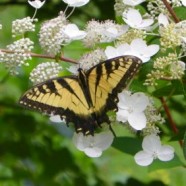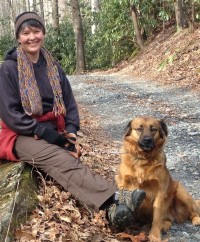Love this plant! Panicle Hydrangea
Any plant that attracts this kind of beauty on a daily basis is going to win points with me!
Read MoreThe Gardener’s Dilemma: To plant or not to plant.
Santa Fe Honey
I remember standing at a farmers market in Santa Fe New Mexico in front of a table lined with jars of amber and gold honey. I was surprised at how much honey the high-desert produces, given the dry scrub covering so much the hilly terrain. The bearded beekeeper in a cowboy hat explained how nearly all of what I saw as “scrub” bloomed, and the bees flourished. He was sharing samples and the tastes were spectacular.
Like the honeys in any region, the different waves of flowers throughout the seasons created different tastes, bouquets, high and low notes, like wines. “But the very favorite honey of my customers, hands down, is autumn clematis honey.” He shook his head slightly, “You can just open the jar and you smell flowers.” He closed his eyes as he said this, as if he was inhaling the scent just now. Before I had time to speak a single word he answered my next question, “I just get it in the fall and I sell out right away, so I can’t offer you any. But people are asking me if I have any the rest of the year.” That was 2010 and I’d never even contemplated keeping bees.
Sweet Autumn Clematis blooms in September and October across the Ozarks and as I drive through town I spot the big green mounds of vines on fences covered up with so small frilly flowers it looks like a blanket of white foam. It is a weedy green vine unremarkable for most of the season. Come autumn, it explodes into a starry blanket of creamy blossoms with a delicious scent. I think back to the Santa Fe honey. That trip was in 2010, before I ever contemplated keeping bees.
These days I look for good things to plant for my bees. I looked up Autumn Clematis only to find that is not native to the US can be invasive/opportunistic in some climates and I’m not really sure if it is a problem in the Ozarks. But then there’s Virgin’s Bower (Clematis virginiana) also called woodbine, which is less showy but native. The native variety has an added bonus of being good for songbird food and nesting materials, though I’ll have to find a special spot to plant it given that it loves a moist setting…. But this is all part of the pleasant mental wrangling gardeners engage in for fun when it’s too cold or wet to dig.
But the thought of new plantings immediately runs into another, one that says I may not be here to see it. By the time it blooms I may be breaking new ground yet again on the home we hope to find when we move back to the Blue Ridge Mountains in the next year.
Ahhh, the gardener’s quandary: If you know you are going to be in a place a relatively short time, do you bother to plant things you will likely never get to see fully grown, or bearing fruits or flowers or shade?
I once read a story about a Quaker gardener, a woman, who lived in a town about to be invaded by German troops in World War II. At least that’s the way I remember the story began. Just before she left her home to escape to a neighboring country, she was planting seeds in her vegetable garden. I don’t remember what. Neighbors thought she was crazy to be planting just before leaving and said, ‘You won’t be here to eat it!’ Her answer something like ‘Whoever lives in this house next, they will need to eat.’
Oh those beautiful Quakers. This story has stuck with me for decades, the compassion of this woman willing to plant food she would never eat. Another way I’ve heard this belief is that ‘true wisdom lies in planting trees even if you will never live long enough to sit in their shade.’ It’s very hard to remember to lift up my attention from my wants, wishes and worries and to think of this land going on into the future without me. But when I do, it feels right. And oddly, I feel better—lighter—about how long I will be here. As a hospice nurse, I can’t help but note the larger echo of that realization.
So let me plant more stuff I may or may not be here to see bloom. If only for the reason that when the wash of white frilly flowers appears in some future autumn, bees will arrive at each bloom. There will be nectar for them.
Are there any quotes or stories that inspire your gardening? I’d love to hear them if you leave a comment (look above or below this post for the “comments” link – the position varies depending on how you are reading this). Also, if anyone knows the source of the Quaker gardener story, I would love to find it again. Special thanks to www.beautifulwildlifegarden.com for some of my favorite online reading. —A Larrapin Garden. Where posts may be boom or bust depending on the season. If you subscribe here you’ll get one weekly email with selected posts. You are also invited to get related miscellany wherever you like to ramble online: Facebook [brand new page…needs your “like”] | Twitter |Pinterest | Instagram. Read MoreHappy Accident in the Weedy Pasture…
Sometimes, things get away from you before you can weedeat! Take this tiny pasture which has thin rocky soil and gets half shady in the fall. I’ve had no luck in growing anything I wanted to grow in it. I intended to knock back the weeds all summer, which at the time were about knee-high, with generic-looking green stalks. (Let me note here, that we never needed a weedeater when we had goats!)
Then the brush got chest high and I dreaded the nightmare weedeating job and put it off longer because now it would involve the gasoline weedeater vs. the lightweight electric. But it was funny to let the chickens run around in their own personal chicken maze, completely invisible once they entered, and scratch around to their hearts’ content. And by then it was far too large for even a herd of biddies to hurt.. Finally, it got so close to first frost that I decided to let winter take it all down….sigh of relief.
But before that happened, everything bloomed. WOW! I’m not sure what these little white aster-like weeds are (anyone?) but the flowers cover the pasture now. And I have never seen so many pollinators in one place at one time! There have been native bees, butterflies, flower flies, and of course the Larrapin honeybees have been all over it. Meanwhile, all kinds of songbirds are hanging around the perimeter have a feast on all the various bugs. (Stay away from the bees you guys!)
You can stand in the middle of it be surrounded by a lively buzz and every flower, I mean every one, has somebody enjoying it. Amazing! My bee mentor told me how much-loved this wildflower is (as one of the last nectar sources of the year) because light frosts actually make the plant produce more nectar.
I’m so very glad I procrastinated this time. Now I have a whole different outlook on this particular “weed.” While I’m a farmer at heart, at the same time, I love what nature does to the land when the farmer steps back a bit and let’s the real master-gardener show me how it’s done! Hope you all are enjoying this beautiful Ozark fall.
—
Read More









